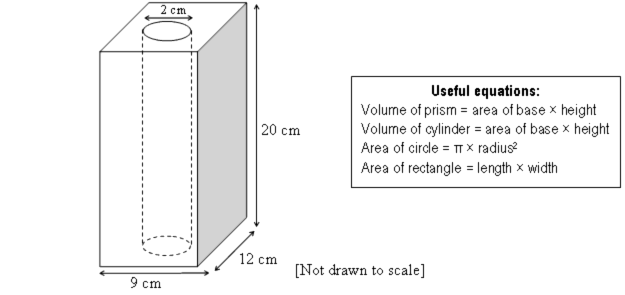Hole in a prism

|
a) Show how to work out the volume of this wooden prism before a cylindrical hole is bored through it.
|
|
|
b) Show how to work out the volume of wood remaining in the prism after a cylindrical hole has been bored through it.
|
| Y10 (05/2007) | ||
| a) |
Correct method for calculating the volume of a cuboid. |
easy |
| b) |
Correct method for calculating the volume of a cylinder. |
difficult |
| Common error | Likely calculation | Likely misconception | |
| a) |
41 420 288 249 |
9 + 12 + 20 20 × (9 + 12) 9 × (20 + 12) 20×12 + 9 |
Uses an additive or partially additive model for computing volume. |
| a) |
108 180 240 |
9 × 12 9 × 20 12 × 20 |
Uses only two of the three dimensions. |
| b) |
Volume of cylinder: 251.3 40 20 80 |
20 × π × 22 2 × 20 1 × 20 2 × 2 × 20 |
Uses the wrong volume for the cylinder • Uses πr2 but with r = 2 rather than r = 1 • Assumes area of base = 2 • Uses half of 2 as the area of the base • Assumes base is a square with sides of 2cm |
NOTE: Several of these misconceptions are combined, leading to a large number of different incorrect numerical responses.
-
Students should firstly explore area, starting with counting unit squares and moving on to multiplication of the number of squares or rectangles in one direction by the number of them in the other. The array model of numeracy that is mentioned below is useful for this.
Resources Making different rectangles, Rectangular area, and Making the largest perimeter help support this. Squares and rectangles provides a more advanced level of this reasoning. - This exploration should then be generalised to multiplying the length of one side by the length of the adjacent side. Some Level 4 resources that support this are Soccer and netball, Same area, different lengths, The Danish flag, and Making road signs.
Students need to understand that area and volume are related to multiplicative reasoning. In particular, the array model of multiplication is particularly useful.
Knowing that volume (cuboid) = width × depth × height
-
Students should firstly explore volume, starting with counting unit cubes and moving on to multiplication of the number of cuboids in each of the three directions.
Resources Cubes and cuboids, Building buildings, How many blocks?, and Blocks in boxes help support this. -
This should be generalised to multiplying the length of each of the three dimensions. Search for Level 4 and 5 resources with keyword: volume. Over half the resources support this model. All of these involve dimensions that are whole numbers rather than decimals or fractions.
This extends the concept of multiplication of three numbers to obtain volume.
Knowing that volume (prism) = area of base × height
This generalisation allows student to move away from cuboids into general rectangular prisms.
- Cuboids: Resources that support this are Packing chocolate, Chocolate measures, Corinth Canal, Packing sweets, or Packing boxes.
- Cylinders: For resources that support search for keywords: volume and cylinders.
Using only two dimensions for volume
Students need to differentiate area as a square measure (i.e. multiplication of two numbers), and volume as a cubic measure (i.e. multiplication of three numbers).
Knowing the way to compute the area of a circle
Students need to know that the relationship between the radius of a circle and its area is given by πr2 - they could explore resources about area of circles.
- Cuboid fish tanks
- Chocolate measures
- Cylinders with the same volume
- Posting a box
- Volume and distance
- Blocks and a cylinder
- Fish tank volume
- Volume and surface area
- Spraying roses
- How big is the dressing table?
- Three oranges
- Enlargement, length and area
- Volume of cuboids
- Measuring cup
- Corinth Canal
- Volume of cream
- Calculating a pyramid
- Measuring a book
- Constructing different shaped boxes

